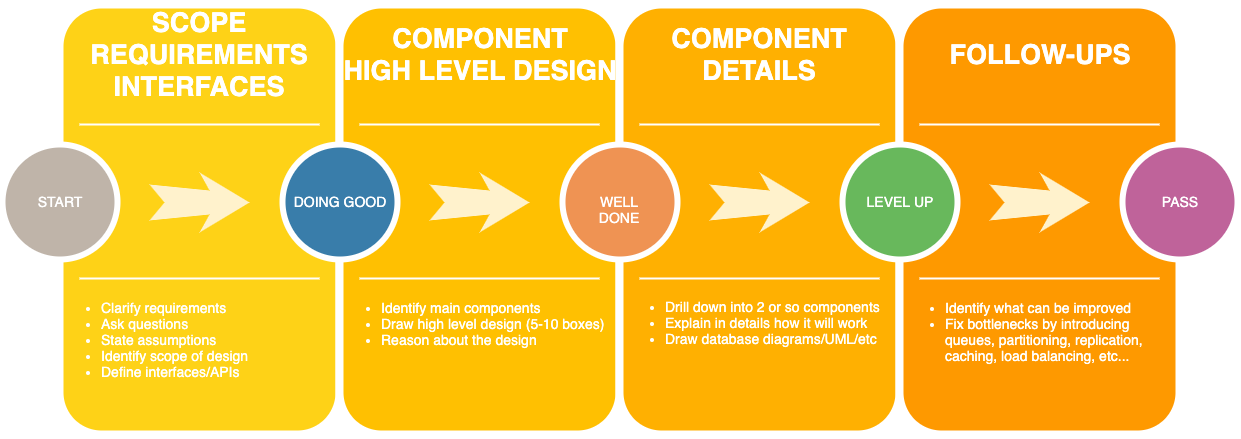Designing something like Dropbox or other well known service is one of the standard System Design Interview (SDI) questions at FAANG companies. This post is for self-educational purposes focused on how to approach SDI question. Also this does not represent how any tech company is designing their software or is interviewing candidates. Though, feel free to use it as a guide for your SDI if you find it useful.
I like to break SDI into four phases. You want to get to the last phase when interviewer is making the problem harder by asking you follow up questions.

Scope, Requirements, Interfaces
The most important part that sets the tone for the entire interview is to clarify requirements with your interviewer. Try to understand what functional and non-functional scope of the problem they expect you to cover.
Functionally Dropbox “offers cloud storage, file synchronization, personal cloud, and client software”. You can list these as bullet points during the interview (any device accessibility, automatic file synchronization, file sharing, file storing, backups, team collaboration, security, etc).
Something like Dropbox will have to handle millions of users, have scalable, available, and performant backend. Ask for number of users, active users, devices, etc to be able to estimate required storage, network capacity and understand if partitioning and how much of replication of data is required. This can be used in calculations later on. Something like: 2K (avg. files) * 500Kb (avg. file size) * 1B (tot. users) ~= 1PB (file storage).
It is always a good idea to define interfaces of your system. APIs exposed by server are usually a great way to start. Define interfaces like list of REST calls or just names of APIs.
Component High Level Design
After gathering the requirements and documenting main interfaces proceed to listing major components of the system. You might not be able to list everything, so mentioning that there are other aspects that you not fully covering, but can get back to them when required (examples could be: authentication, payment system, integration with external systems, etc).
At this stage you should arrive at key ideas to solving the design. Key ideas for designing Dropbox could be: split large files into multiple chunks; keep chunk metadata in database locally and sync to server; receive and upload files via synchronization queues.
Once key solution ideas are clear, draw some boxes. It is best to start from top and proceed to details. In our Dropbox example it could be Backend and Frontend. Backend could consist of File Storage, Metadata Database, App Servers and Queues. Our Client could be split into logical parts. Many similar posts (not sure about origin) suggest to split client into Chunker (split files into multiple), Watcher (watches local folders and server for updates), Indexer (processes watcher events), InternalDb (stores metadata).
Component Details
Obviously, it is impossible to cover gigantic system, like Dropbox, in 45 minutes, so you have to focus on few aspects that are important. For instance, you can focus on database design for metadata by drawing tables and their relations, or instead you can focus on how updates will be sent to other devices by drawing sequence diagram, etc.
This could be the best stage to show your depth of the knowledge in one or the other area. More often then not interviewer would be happy to focus on area you are comfortable with and then would ask you follow-up questions to understand the depth of your knowledge and whether you really know what you are talking about or just making things up while throwing buzz-words. It should go without saying that you should not be doing this.
Follow-Ups
It is a very good sign when interviewer starts to make the problem harder as it means you are doing really good. At this stage the interview can go into any direction depending on the interviewer, but often you would need to solve scalability problems (queues, caches, load balancers), availability (replications), or you could be asked to increase the scope of functionality that would make you add new components, etc.
Conclusion
This is my concise view on the parts of SDI, though your experience could be totally different depending on the interviewer, company, level targeted and specifics of a question (like, say, designing fridge controller).
I recommend reading the book “Designing Data Intensive Applications” as it is absolutely great resource to train yourself whether you are preparing yourself for interview or just trying to solidify design skills. You can also try watching youtube videos and googling articles like this.

codemore code
~~~~